Hi everyone,
Thought it would be best if I posted here first. I am not currently a P6 owner (nor have ever been one) but am hoping to be one soon. This post was supposed to be brief but soon got out of control, so apologies in advance...
My car history is 100% Land-rover up until this point, my first car was a 1959 88" series II which I still own, and drove daily for about 5 years. Then bought a house and moved 25 miles away from my place of employment and so bouncing along in a drum braked, leaf sprung vehicle everyday became slightly less practical.
That was when my current daily drive came on the scene - a B-registered 90 which in the 5 or 6 years I have owned it has become a bit like Triggers Broom. When I bought it I had to replace the rear crossmember, fuel tank and buy a roof to get it back on the road. Since then I have:
When I bought it I had to replace the rear crossmember, fuel tank and buy a roof to get it back on the road. Since then I have:
Fitted LPG to the vehice - the 2.25 4 cylinder was a thirsty lump, slow and not very economical. LPG was a godsend...
Replaced the old 2.25 4-pot for a 3.5 v8 that I lightly rebuilt. (Glaze busted bores, new rings, bearings, cam & followers, timing gears and chain, ground in valves, refaced oil pump base, rebuilt carbs).
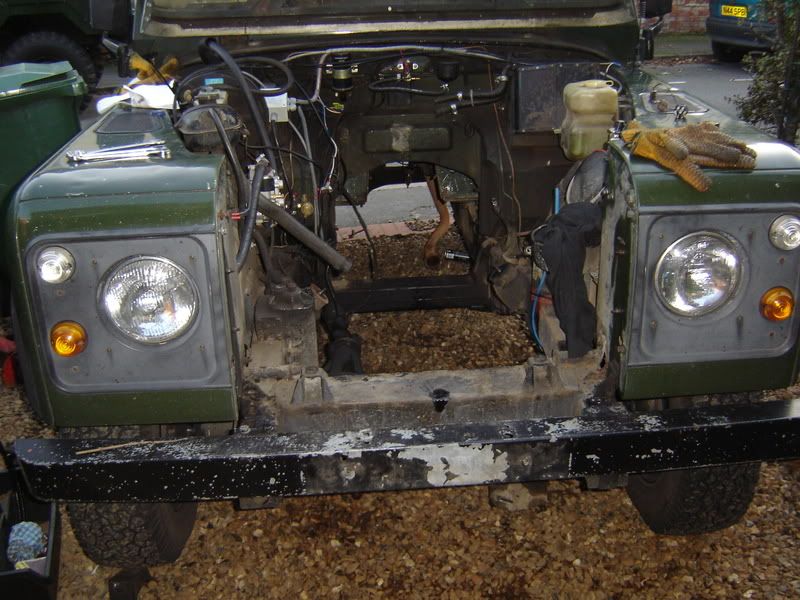

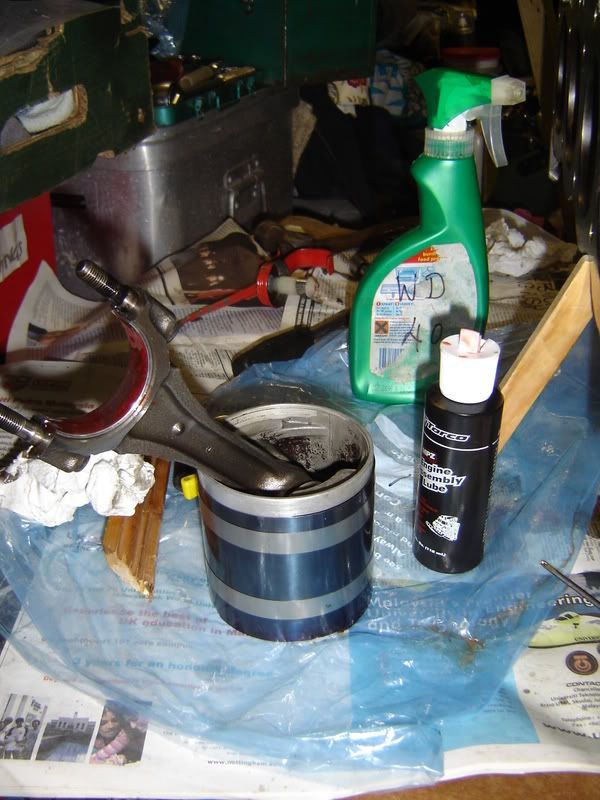
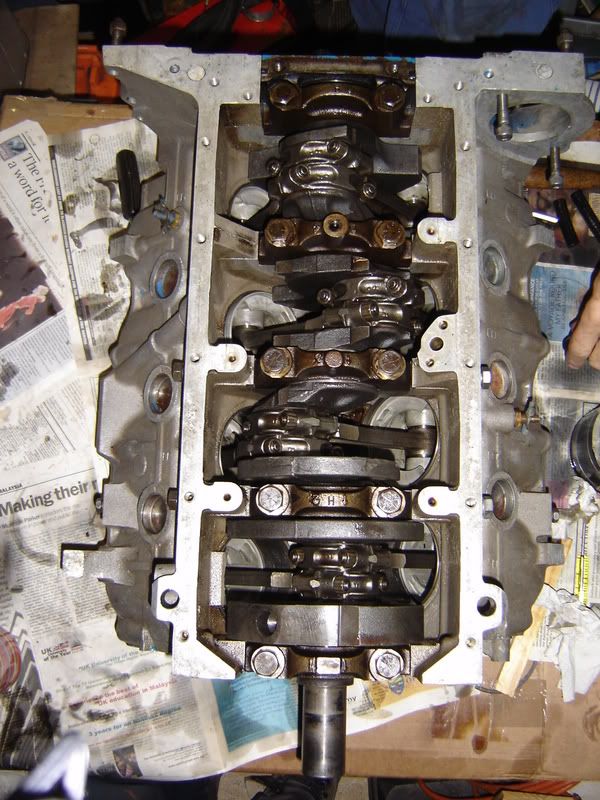
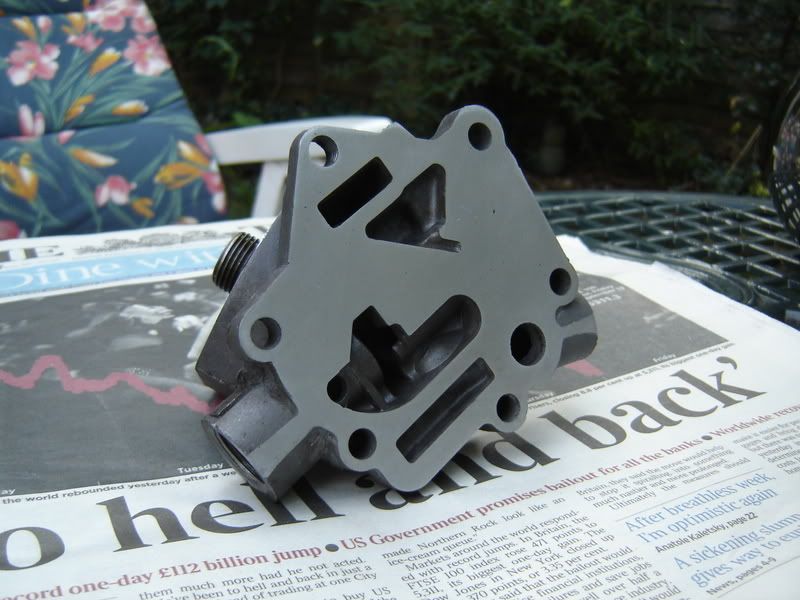
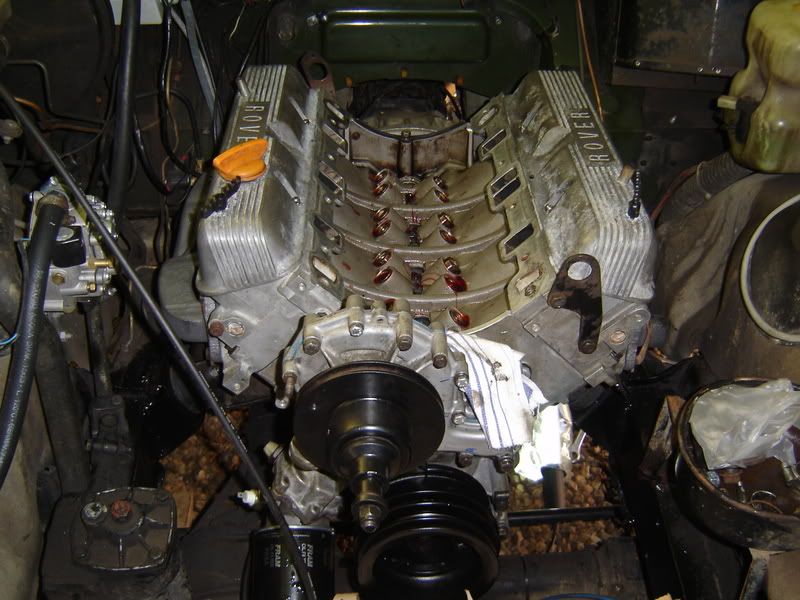
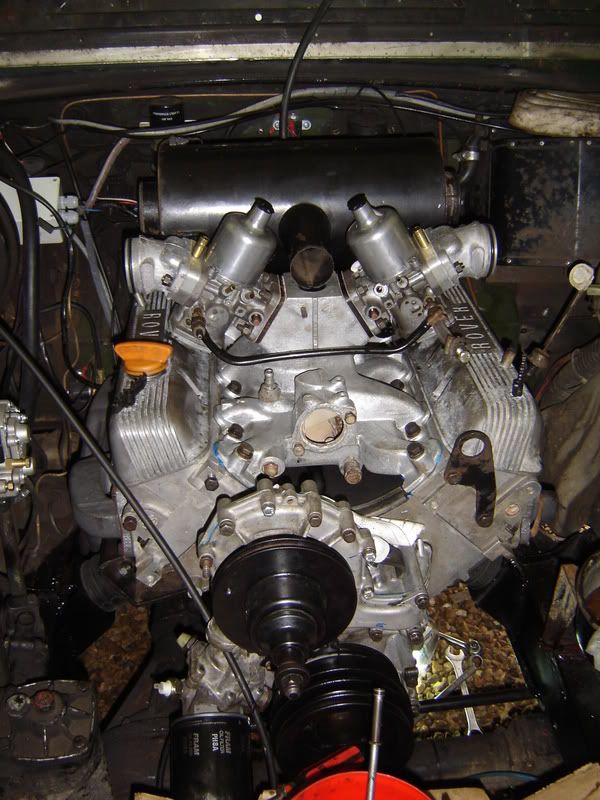
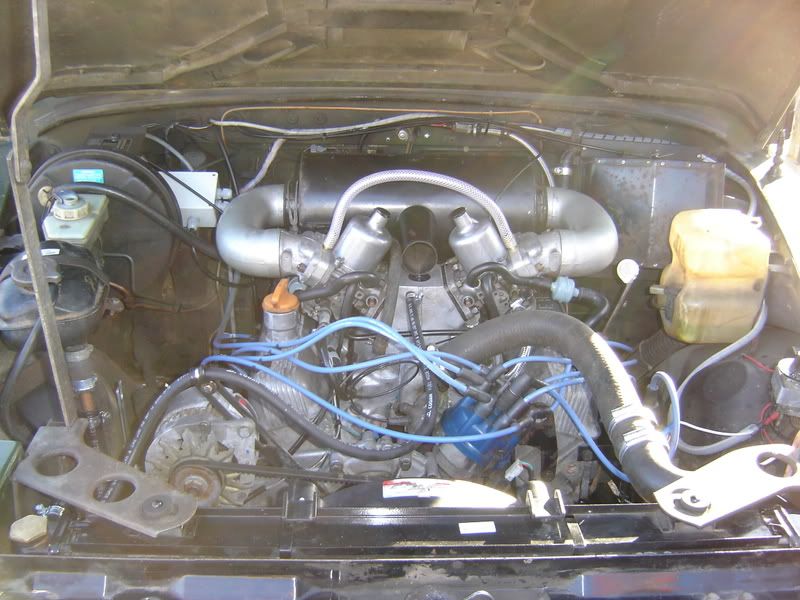
I then got the LPG running on the v8 to save my wallet.
Next was distributorless ignition using "MegaJolt", heres a link to my install thread on LR4x4.com:
http://forums.lr4x4.com/index.php?showtopic=50799
This gave me a much nicer, more precise spark and the ability to run two advance curves to suit the two fuels.
Replaced the gearbox (a few times). The v8 Lt77 I fitted was an ebay purchase, I took it home and as it was clean I put it in my parents garage where it sat for a year before I did the v8 conversion. On getting it into the car I drained the fluid to find it was half full of water -yikes! - it must have been pressure washed by the previous owner. I decided to go with it as it was in and it ran it for 9 months before a bearing failed. I then rebuilt the box myself after having problems with a few reconditioned units. Apart from putting a spring clip in backwards causing it grab fourth which necessitated the removal and rebuilding a second time some 500 miles after fitting its all been roses ever since
Rear axle was replaced with a disc braked unit that I rebuilt from a Range Rover. It now stops the same as it did with rear drums, but with less fade when towing or on massive hills.
Then the transfer box started whining - so I changed that. The rear prop had play in the sliding joint which clunked when taking up drive so that was replaced too.
The snow and ice of the last few years and the accompanying salt, coupled with the 70mph winds that the canvas top was being subjected to up and down the m3 everday finally finished it off - a hard top was fitted in its place.
The front axle was changed as I wanted to fit later alloy wheels that I had picked up, and the existing axle was in need of rebuild. I bought an axle, trailered it back from Devon and rebuilt it.
The last big thing to happen was the fitting of fuel injection and Megasquirt. I now have fully mappable fuel and spark, retaining the ability to switch maps with change from Petrol to LPG. Fuel injection really has transformed the performance of the 3.5 and economy is good too- although I still have more tuning to do there.
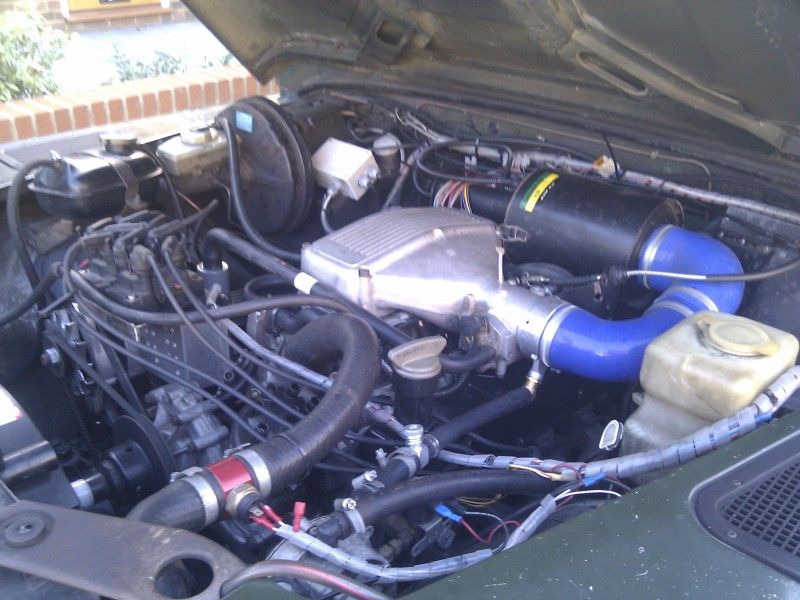
And here it is as it looks now:
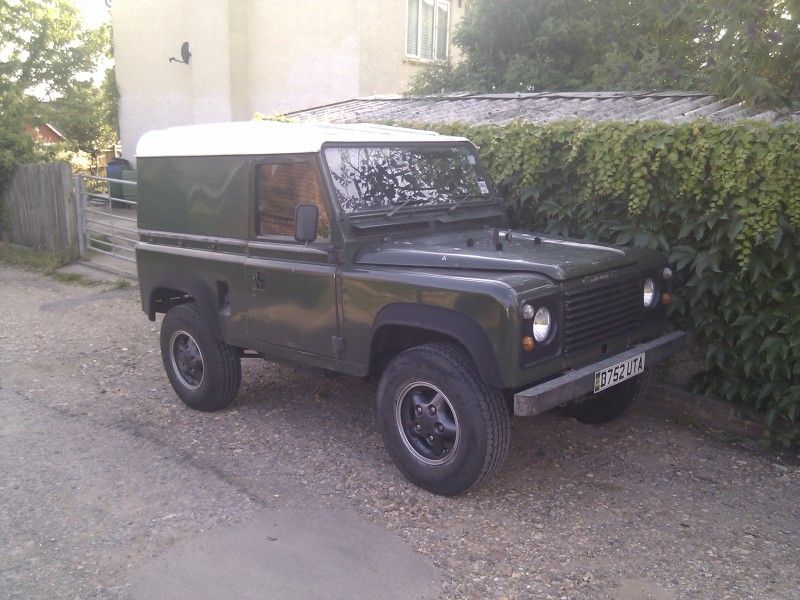
*********************************************************************************************************************
Enough LR content... So- what am I doing here?
Well, for some time I have always wanted either a P6 or an MGB (well i'd like both, but my wife would kill me)- what has pushed me towards the P6 is the fact that to my mind they must be more practical than an MGB, and better for cruising up and down the a3, which my current commute has me doing.
This is coupled with the fact that my company is moving office locations to the centre of Kingston Upon Thames and I will therefore have to park in one of the various NCP's around the place - something the height of the 90 makes difficult.
I have been doing a bit of reading and think a 2200TC Auto might be nice, it HAS to be more comfortable at cruise on the A3 than the 90 but should save my left leg when battling into Kingston and the figures owners have posted on fuelly.com for the 4 cylinder models look pretty good! I only say the 2200 over the 2000 due to the lower compression ratio and modern fuels.
Ideally I would be looking for something perhaps a little tatty, maybe in need of some welding but basically sound. It would be great to have something that needs some work to get it up and running, allowing me to get to know my new friend before getting stuck into more serious things.
So, my questions to the collective are these:
Does my choice of model sound reasonable? Or are there other options - I am open to buying things and swapping parts over to get the right result.
Where should I be looking for rust - sills, floor under carpets, wheel arches - any other moisture/mud traps?
Are there any bits that you simply cannot get hold of anymore? Where do you get bits from? I have been spoiled with the multitude of landrover parts suppliers online.
Where are the best places to find P6's advertised as for sale? Apart from here...
Many thanks in advance to anyone who has got this far! Apologies for the long post...
Jamie
Thought it would be best if I posted here first. I am not currently a P6 owner (nor have ever been one) but am hoping to be one soon. This post was supposed to be brief but soon got out of control, so apologies in advance...
My car history is 100% Land-rover up until this point, my first car was a 1959 88" series II which I still own, and drove daily for about 5 years. Then bought a house and moved 25 miles away from my place of employment and so bouncing along in a drum braked, leaf sprung vehicle everyday became slightly less practical.
That was when my current daily drive came on the scene - a B-registered 90 which in the 5 or 6 years I have owned it has become a bit like Triggers Broom.
Fitted LPG to the vehice - the 2.25 4 cylinder was a thirsty lump, slow and not very economical. LPG was a godsend...
Replaced the old 2.25 4-pot for a 3.5 v8 that I lightly rebuilt. (Glaze busted bores, new rings, bearings, cam & followers, timing gears and chain, ground in valves, refaced oil pump base, rebuilt carbs).








I then got the LPG running on the v8 to save my wallet.
Next was distributorless ignition using "MegaJolt", heres a link to my install thread on LR4x4.com:
http://forums.lr4x4.com/index.php?showtopic=50799
This gave me a much nicer, more precise spark and the ability to run two advance curves to suit the two fuels.
Replaced the gearbox (a few times). The v8 Lt77 I fitted was an ebay purchase, I took it home and as it was clean I put it in my parents garage where it sat for a year before I did the v8 conversion. On getting it into the car I drained the fluid to find it was half full of water -yikes! - it must have been pressure washed by the previous owner. I decided to go with it as it was in and it ran it for 9 months before a bearing failed. I then rebuilt the box myself after having problems with a few reconditioned units. Apart from putting a spring clip in backwards causing it grab fourth which necessitated the removal and rebuilding a second time some 500 miles after fitting its all been roses ever since
Rear axle was replaced with a disc braked unit that I rebuilt from a Range Rover. It now stops the same as it did with rear drums, but with less fade when towing or on massive hills.
Then the transfer box started whining - so I changed that. The rear prop had play in the sliding joint which clunked when taking up drive so that was replaced too.
The snow and ice of the last few years and the accompanying salt, coupled with the 70mph winds that the canvas top was being subjected to up and down the m3 everday finally finished it off - a hard top was fitted in its place.
The front axle was changed as I wanted to fit later alloy wheels that I had picked up, and the existing axle was in need of rebuild. I bought an axle, trailered it back from Devon and rebuilt it.
The last big thing to happen was the fitting of fuel injection and Megasquirt. I now have fully mappable fuel and spark, retaining the ability to switch maps with change from Petrol to LPG. Fuel injection really has transformed the performance of the 3.5 and economy is good too- although I still have more tuning to do there.

And here it is as it looks now:

*********************************************************************************************************************
Enough LR content... So- what am I doing here?
Well, for some time I have always wanted either a P6 or an MGB (well i'd like both, but my wife would kill me)- what has pushed me towards the P6 is the fact that to my mind they must be more practical than an MGB, and better for cruising up and down the a3, which my current commute has me doing.
This is coupled with the fact that my company is moving office locations to the centre of Kingston Upon Thames and I will therefore have to park in one of the various NCP's around the place - something the height of the 90 makes difficult.
I have been doing a bit of reading and think a 2200TC Auto might be nice, it HAS to be more comfortable at cruise on the A3 than the 90 but should save my left leg when battling into Kingston and the figures owners have posted on fuelly.com for the 4 cylinder models look pretty good! I only say the 2200 over the 2000 due to the lower compression ratio and modern fuels.
Ideally I would be looking for something perhaps a little tatty, maybe in need of some welding but basically sound. It would be great to have something that needs some work to get it up and running, allowing me to get to know my new friend before getting stuck into more serious things.
So, my questions to the collective are these:
Does my choice of model sound reasonable? Or are there other options - I am open to buying things and swapping parts over to get the right result.
Where should I be looking for rust - sills, floor under carpets, wheel arches - any other moisture/mud traps?
Are there any bits that you simply cannot get hold of anymore? Where do you get bits from? I have been spoiled with the multitude of landrover parts suppliers online.
Where are the best places to find P6's advertised as for sale? Apart from here...
Many thanks in advance to anyone who has got this far! Apologies for the long post...
Jamie

